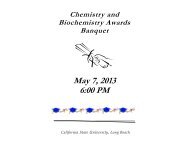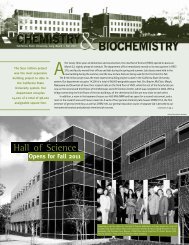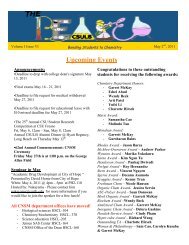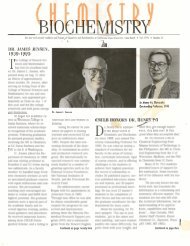2010 - California State University, Long Beach Department of ...
2010 - California State University, Long Beach Department of ...
2010 - California State University, Long Beach Department of ...
Create successful ePaper yourself
Turn your PDF publications into a flip-book with our unique Google optimized e-Paper software.
Reports from Faculty<br />
Bromide-Capped Gold Nanoparticles: Effects <strong>of</strong><br />
Anion Treatments,” was published in Colloids and<br />
Surface; A. Shaeleen Chuc and Parfait Voundi,<br />
both undergraduate students, are the only other<br />
co-authors. Two other papers were the results <strong>of</strong><br />
collaboration with Dr. Kwon’s group in the<br />
<strong>Department</strong> <strong>of</strong> Physics or Dr. Slowinski’s group in<br />
our department. Two undergraduate students,<br />
Nicole Choi and Michael Aquino, contributed to<br />
the research and are listed as co-authors. In<br />
addition, we recently submitted a paper on the<br />
catalytic property <strong>of</strong> Pd nanoparticles. A<br />
graduate student, Elham Sadeghmoghaddam,<br />
discovered that Pd nanoparticles are a good and<br />
selective catalyst for the isomerization <strong>of</strong> allyl<br />
alcohol to propanal.<br />
Linh Tran, another graduate student, is<br />
getting closer to the synthesis <strong>of</strong> his target<br />
final product, water-soluble nanoparticlecored<br />
dendrimers. Erick Ovalle and Wendy<br />
Chaing also studied the synthesis <strong>of</strong> monodisperse<br />
nanoparticle-cored dendrimers in the<br />
past year. Wendy received the American Institute<br />
<strong>of</strong> Chemists Undergraduate Award this<br />
year. Besides Elham, Hanmo Gu and Zachariah<br />
Mel investigated catalytic isomerization and<br />
hydrogenation reactions using Pd nanoparticles<br />
with different structure and composition.<br />
Michael Aquino, Leeann Korprapun, Josephine<br />
Yee and Paul Vaccarello participated in the<br />
preparation <strong>of</strong> Au, Ag and AuAg nanoisland<br />
films for optical sensing <strong>of</strong> biomolecules. Parfait<br />
Voundi and Phuong Nguyen studied the<br />
conductivity <strong>of</strong> different nanoparticle films<br />
upon exposure to volatile organic compounds.<br />
Parfait received a CSU LSAMP Scholarship for<br />
the 2009-10 academic year. Besides Wendy,<br />
Erick, Hanmo, Michael, Parfait and Phuong are<br />
leaving my research group after completing<br />
their degree programs in this past year. Several<br />
other students are also getting close to<br />
the completion <strong>of</strong> their course work. Therefore,<br />
it is anticipated that we will have a lot<br />
<strong>of</strong> changes over the next year, and I am certainly<br />
looking forward to the challenge.<br />
Dr. Kris Slowinski<br />
With support from the Research Corporation<br />
and ACS-PRF, my laboratory continues to perform<br />
research on electrical properties <strong>of</strong> nanostructures.<br />
We have published a paper (in collaboration with<br />
Shon’s group) on the relative efficiencies <strong>of</strong><br />
electron tunneling across self-assembled mono -<br />
layers (SAMs) <strong>of</strong> n-alkanethiols and n-alkan e-<br />
s elenols, (E. Adaligil, Y.S. Shon, and K. Slowinski,<br />
Langmuir, <strong>2010</strong>, 26 (3), pp 1570–1573) and<br />
another paper (E. Adaligil, and K. Slowinski,<br />
J. Electroanal. Chem., <strong>2010</strong>, in press) describing<br />
unusual effects <strong>of</strong> aliphatic alcohols on longrange<br />
electrochemical electron transfer across<br />
alkanethiol monolayers. We continued our<br />
research on electrical properties <strong>of</strong> DNA and<br />
published a paper (in collaboration with Mike Hill<br />
at Occidental College) on spatially resolved<br />
electrochemical detection <strong>of</strong> DNA lesions using<br />
gold electrodes modified with DNA monolayers<br />
(W.J. Hammond, J. Arndt, T. Nguyen, K.U.<br />
Slowinska, C. Jackson, H.A. Burgoyne, M.G. Hill,<br />
and K. Slowinski, ECS Transactions, 2009, 16<br />
(38), 55).<br />
Two graduate students left the group<br />
this academic year. Bill Hammond graduated<br />
in January and is currently attending medical<br />
school at Boston <strong>University</strong>. Emel Adaligil<br />
graduated in June and is currently enrolled in<br />
a Ph.D. program at Tufts <strong>University</strong>. In May<br />
<strong>2010</strong>, I was awarded an NIH-SC3 grant for<br />
the project titled “Biosensing in electrochemically<br />
controlled nano-junctions.” The grant<br />
will provide $75,000 per year for four years<br />
and will allow my group to continue our<br />
research on the conductivity <strong>of</strong> DNA. My group<br />
now consists <strong>of</strong> eight undergraduate students:<br />
Sara Agahi, Jason Barca, Jason Chang, William<br />
Do, Andrew Nguyen, David Roeuth, Jonathan<br />
Thang and Tri Tran, who are eagerly looking<br />
forward to a very productive summer.<br />
I have served as department vice-chair<br />
for the last two years and collaborated with<br />
department Chair Jeff Cohlberg on several<br />
projects aimed at improving the quality <strong>of</strong><br />
instruction in our department. We have developed<br />
a formal departmental policy concerning<br />
lecturer evaluations and established a new<br />
departmental award given annually to an outstanding<br />
teaching associate. I have proposed<br />
to develop standard course outlines for the<br />
general chemistry sequence (Chem 101, 111A,<br />
111B) to ensure uniform standards in multiple<br />
section courses (the outlines were developed<br />
and approved by the Freshman Chemistry<br />
Committee). I also organized mid-semester<br />
teaching evaluations for all teaching associates.<br />
These evaluations give our teaching associates<br />
an important insight into what and how students<br />
are learning. Moreover, the mid-semester<br />
evaluations provide students with an opportunity<br />
to anonymously communicate with TAs<br />
about the course.<br />
Following the evaluations, the graduate<br />
students meet with me individually, if necessary,<br />
to discuss their evaluations and to sug-<br />
gest possible ways to improve their teaching<br />
effective ness. I have also organized a new workshop<br />
for teaching associates who are scheduled<br />
to teach courses in the department. The workshop<br />
is held every semester and is devoted to<br />
hands-on experience in classroom activities in<br />
general chemistry. Students are asked to lead a<br />
15-minute mock discussion session, which is<br />
videotaped. The taped presentations are analyzed<br />
and discussed.<br />
Finally, I spent a significant amount <strong>of</strong><br />
time working alongside Drs. Brazier, Buonora,<br />
Li and Weers on a new departmental RTP policy,<br />
and I am very glad that our proposal was<br />
approved almost unanimously.<br />
Dr. Eric Sorin<br />
Having just completed my third year at<br />
CSULB, the past 12 months have provided me<br />
with some new and exciting experiences. First<br />
and foremost, we submitted our first NIH grant<br />
proposal (co-authored by students Sarav Patel<br />
and Mona Bakhom) and our lab’s first two manuscripts.<br />
While our grant was not funded, our<br />
manuscripts were both published in early <strong>2010</strong>.<br />
The first, a study <strong>of</strong> the accuracy <strong>of</strong> molecular<br />
models applied to helical peptides and proteins,<br />
was published in PLoS ONE. The second, which<br />
focuses on the folding and equilibrium dynamics<br />
<strong>of</strong> a small RNA structural motif, was accepted<br />
as a featured article in Nucleic Acids Research.<br />
These articles were co-authored by my<br />
first group <strong>of</strong> graduating students, including<br />
biochemistry major Allison DePaul, chemical<br />
engineering major Erik Thompson, mathematics<br />
and statistics major Kristin Haldeman and<br />
biochemistry major Sarav Patel. Allison, who<br />
gave her first oral presentation at the regional<br />
ACS undergraduate research conference this<br />
spring, is headed <strong>of</strong>f to the Pharm.D. program at<br />
UC San Francisco, and Kristin is thrilled to be<br />
entering the biostatistics Ph.D. program at UC<br />
Davis. Sarav, who presented a poster at the<br />
regional AAAS conference in Oregon in June, has<br />
been accepted to the M.D. program at U.C. Irvine.<br />
Erik is continuing his participation in the Sorin<br />
lab as he enters the local job market. It is truly<br />
difficult to watch these students, and now close<br />
friends, leave our lab and our community, but it<br />
is also exhilarating to see them realizing their<br />
dreams. I couldn’t be more proud <strong>of</strong> my first crop<br />
<strong>of</strong> CSULB undergraduates!<br />
Indeed, Sorin lab students have had a very<br />
successful year: Erik won this year’s Hypercube<br />
Award in Computational Chemistry; Yi An<br />
Continued on pg. 21, Reports from Faculty<br />
13



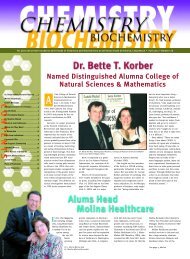
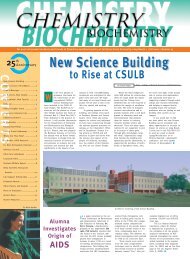
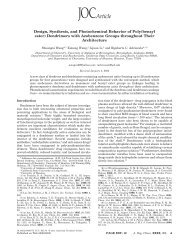
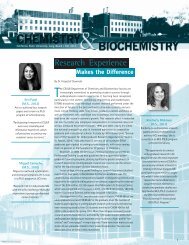
![Volume 4, Issue 3 [November 2012 pdf] - California State University ...](https://img.yumpu.com/34605825/1/190x245/volume-4-issue-3-november-2012-pdf-california-state-university-.jpg?quality=85)
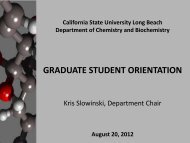
![Volume 5, Issue 2 [April 2013 pdf] - California State University, Long ...](https://img.yumpu.com/33273195/1/190x245/volume-5-issue-2-april-2013-pdf-california-state-university-long-.jpg?quality=85)
